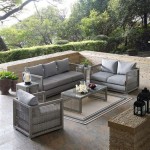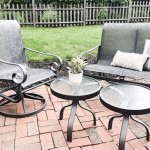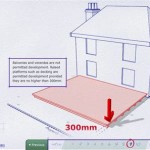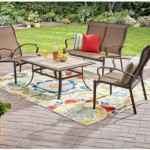Designing The Perfect Patio Furniture Layout Plans
Creating an inviting and functional patio space requires careful planning, and at the heart of this planning lies the furniture layout. The arrangement of furniture can significantly impact the usability, aesthetics, and overall atmosphere of the patio. Optimizing the layout enhances outdoor living, promotes relaxation, and facilitates social interaction. Thoughtful design considers various factors including the patio's dimensions, intended uses, personal style preferences, and environmental conditions. Effective patio furniture layout plans are not random; they are the result of a deliberate process that combines practicality with visual appeal.
The goal is to create a space that feels both comfortable and functional, allowing individuals to fully enjoy their time outdoors. A well-designed patio layout can transform a simple outdoor area into an extension of the indoor living space, fostering a seamless transition between the two environments. The following points delve into key aspects of patio furniture layout planning, offering insights into creating a truly exceptional outdoor oasis.
Understanding Patio Dimensions and Spatial Constraints
Before selecting and arranging furniture, a thorough understanding of the patio's dimensions is essential. Precise measurements of the length, width, and height (particularly if the patio is covered) should be taken. These measurements provide a foundation for determining the appropriate scale and quantity of furniture. Small patios benefit from space-saving designs such as folding chairs or nesting tables, while larger patios can accommodate more substantial pieces like outdoor sofas and dining sets. An accurate assessment of the available space prevents overcrowding and ensures comfortable movement. It is beneficial to create a scaled drawing or use patio design software to visualize different furniture arrangements within the given dimensions. This visual representation helps identify potential problem areas and optimize the layout before any actual furniture purchases are made. Spatial awareness extends beyond the immediate patio area and includes consideration of surrounding features such as landscaping, walkways, and access points to the house. These factors influence traffic flow and must be integrated into the layout plan to create a harmonious and user-friendly space.
Consider the shape of the patio as well. Square patios lend themselves to symmetrical arrangements, while rectangular patios may benefit from a divided layout creating distinct zones for different activities. Irregularly shaped patios require more creative solutions, often involving angled placements or the use of curved furniture to maximize space utilization. The presence of architectural features, such as columns or built-in planters, should also be noted as these may dictate furniture placement or serve as focal points within the design. A comprehensive understanding of these spatial constraints is paramount to achieving a functional and aesthetically pleasing patio layout.
Furthermore, taking into account overhead obstructions, such as trees or awnings, will help determine the ideal placement for taller pieces of furniture. Low-hanging branches may limit the height of umbrellas or pergolas, while awnings may cast shadows that affect seating arrangements. It is also important to consider the prevailing wind direction, as this can influence the placement of lightweight furniture or the need for windbreaks. By carefully analyzing these various spatial factors, a patio layout can be tailored to the specific characteristics of the outdoor environment, ensuring both comfort and practicality.
Defining Zones and Intended Uses
A successful patio furniture layout plan starts with defining distinct zones based on the intended uses of the space. Consider the activities that will primarily take place on the patio, such as dining, relaxing, entertaining, or cooking. Each activity requires a dedicated zone with specific furniture and accessories. For example, a dining zone necessitates a table and chairs, ideally positioned near the kitchen for easy access. A relaxation zone often features comfortable seating such as lounge chairs, sofas, or hammocks, accompanied by side tables for drinks and books. An entertainment zone may include a fire pit, outdoor bar, or television, requiring seating arrangements that facilitate conversation and viewing. Clearly defining these zones helps organize the space and ensures that the furniture is appropriately selected and arranged for each activity.
The size and configuration of each zone should reflect the frequency and intensity of its use. A frequently used dining zone may require a larger table and more seating, while a less frequently used relaxation zone may only need a couple of lounge chairs. It is also important to consider the needs of different users. A family with young children may require a play area on the patio, while an individual who enjoys gardening may need a designated space for potting plants and storing tools. By tailoring the zones to the specific needs and preferences of the users, the patio becomes a more personalized and functional extension of the home.
When defining zones, consider the flow between them. The layout should facilitate easy movement from one zone to another, avoiding obstacles or cramped pathways. This can be achieved by strategically placing furniture to create clear passageways and maintaining a comfortable distance between different seating areas. The visual connection between zones is also important. Using cohesive colors, materials, and styles across different zones creates a sense of unity and harmony. Alternatively, subtle transitions in flooring materials or landscaping can subtly demarcate different zones while still maintaining a cohesive design. By carefully considering the flow and connection between zones, a patio can be transformed into a dynamic and engaging outdoor living space.
Selecting Furniture Styles and Materials
The choice of furniture styles and materials plays a crucial role in the overall aesthetic and functionality of the patio. The style of furniture should complement the architectural style of the house and reflect the personal taste of the homeowner. Consider whether a modern, traditional, rustic, or eclectic style best suits the overall design vision. Modern furniture often features clean lines, minimalist designs, and materials such as metal, glass, and concrete. Traditional furniture tends to be more ornate, with intricate details and materials such as wood, wicker, and wrought iron. Rustic furniture embraces natural elements such as wood, stone, and leather, creating a warm and inviting atmosphere. Eclectic furniture combines different styles and materials, allowing for a more personalized and unique design.
Beyond aesthetics, the choice of materials should also be driven by durability, weather resistance, and maintenance requirements. Outdoor furniture is exposed to the elements, so it is essential to select materials that can withstand sun, rain, wind, and temperature fluctuations. Teak, cedar, and redwood are popular choices for wood furniture due to their natural resistance to rot and insects. Aluminum and stainless steel are durable and rust-resistant options for metal furniture. Wicker furniture, whether made from natural rattan or synthetic fibers, offers a classic and comfortable look but may require more maintenance. Cushions and upholstery should be made from weather-resistant fabrics such as Sunbrella or Olefin, which are resistant to fading, mildew, and stains.
Consider the long-term maintenance requirements of different materials. Wood furniture may require periodic staining or sealing to protect it from the elements. Metal furniture may need occasional cleaning to remove rust or grime. Wicker furniture may need to be protected from excessive moisture to prevent mildew. By selecting furniture styles and materials that are both aesthetically pleasing and durable, a patio can be transformed into a long-lasting and enjoyable outdoor living space. Incorporating outdoor rugs can also define spaces, add warmth, and protect the patio surface. The color and texture of the rugs should complement the furniture and overall design scheme. Finally, consider adding accessories such as throw pillows, blankets, and outdoor lighting to enhance comfort and create a welcoming atmosphere. These small details can make a big difference in the overall look and feel of the patio.
In addition to the primary furniture, consider incorporating elements that enhance the usefulness and enjoyment of the patio. This might include planters filled with flowers or herbs, a water feature for creating a relaxing ambiance, or an outdoor kitchen for extended entertaining. These additions should be integrated into the overall layout plan, ensuring that they complement the furniture and contribute to the functionality of the space. Ultimately, the goal is to create a patio that is not only visually appealing but also practical and enjoyable for all who use it.

How To Design The Perfect Outdoor Space

Designing The Perfect Small Outdoor Space Lifescape Colorado

How To Design The Perfect Patio Dk Studio

From Patios To Pools The Best Outdoor Living Space Ideas

Backyard Patio Ideas Small Covered Concrete Brick And Wood

Designing The Perfect Patio In 7 Steps

How To Design A Spacious Outdoor Living Area With The Right Furniture

Designing The Perfect Outdoor Oasis Patio Furniture Space Planning Ma

How To Plan And Design The Perfect Outdoor Kitchen

How To Design And Build Your Perfect Outdoor Patio Space
See Also








